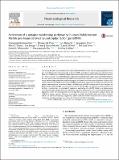Files in this item
Activation of a synapse weakening pathway by human Val66 but not Met66 pro-brain-derived neurotrophic factor (proBDNF)
Item metadata
| dc.contributor.author | Kailainathan, Sumangali | |
| dc.contributor.author | Piers, Thomas M. | |
| dc.contributor.author | Yi, Jee Hyun | |
| dc.contributor.author | Choi, Seongmin | |
| dc.contributor.author | Fahey, Mark S. | |
| dc.contributor.author | Borger, Eva | |
| dc.contributor.author | Gunn-Moore, Francis James | |
| dc.contributor.author | O'Neill, Laurie | |
| dc.contributor.author | Lever, Michael | |
| dc.contributor.author | Whitcomb, Daniel J. | |
| dc.contributor.author | Cho, Kwangwook | |
| dc.contributor.author | Allen, Shelley J. | |
| dc.date.accessioned | 2016-01-12T17:10:04Z | |
| dc.date.available | 2016-01-12T17:10:04Z | |
| dc.date.issued | 2016-02 | |
| dc.identifier | 240125432 | |
| dc.identifier | 8de63e50-992a-4868-8fed-462a7e1b0206 | |
| dc.identifier | 84952886825 | |
| dc.identifier | 000371841800010 | |
| dc.identifier.citation | Kailainathan , S , Piers , T M , Yi , J H , Choi , S , Fahey , M S , Borger , E , Gunn-Moore , F J , O'Neill , L , Lever , M , Whitcomb , D J , Cho , K & Allen , S J 2016 , ' Activation of a synapse weakening pathway by human Val66 but not Met66 pro-brain-derived neurotrophic factor (proBDNF) ' , Pharmacological Research , vol. 104 , pp. 97-107 . https://doi.org/10.1016/j.phrs.2015.12.008 | en |
| dc.identifier.issn | 1043-6618 | |
| dc.identifier.other | ORCID: /0000-0003-3422-3387/work/34730417 | |
| dc.identifier.other | ORCID: /0000-0003-4965-2969/work/30766999 | |
| dc.identifier.uri | https://hdl.handle.net/10023/8008 | |
| dc.description | This work has been supported by Bristol Research into Alzheimer’s and Care of the Elderly (BRACE), the Sigmund Gestetner Trust Fund (University of Bristol), the Alzheimer’s Society and the Alumni of the University of Bristol. K.C. and D.J.W. were supported by UK Wellcome Trust-MRC Neurodegenerative Disease Initiative Programme. J.H.Y. was supported by the Korea-UK Alzheimer’s Research Consortium Programme under the Korean Ministry of Health and Welfare. T.M.P. and S.C. were supported by Bristol-Chonnam Frontier Programme under the Chonnam National University Hospital. K.C. was supported by the Wolfson Research Merit Award and Royal Society, London. | en |
| dc.description.abstract | This study describes a fundamental functional difference between the two main polymorphisms of the pro-form of brain-derived neurotrophic factor (proBDNF), providing an explanation as to why these forms have such different age-related neurological outcomes. Healthy young carriers of the Met66 form (present in ∼30% Caucasians) have reduced hippocampal volume and impaired hippocampal-dependent memory function, yet the same polymorphic population shows enhanced cognitive recovery after traumatic brain injury, delayed cognitive dysfunction during aging, and lower risk of late-onset Alzheimer’s disease (AD) compared to those with the more common Val66 polymorphism. To examine the differences between the protein polymorphisms in structure, kinetics of binding to proBDNF receptors and in vitro function, we generated purified cleavage-resistant human variants. Intriguingly, we found no statistical differences in those characteristics. As anticipated, exogenous application of proBDNF Val66 to rat hippocampal slices dysregulated synaptic plasticity, inhibiting long-term potentiation (LTP) and facilitating long-term depression (LTD). We subsequently observed that this occurred via the glycogen synthase kinase 3β (GSK3β) activation pathway. However, surprisingly, we found that Met66 had no such effects on either LTP or LTD. These novel findings suggest that, unlike Val66, the Met66 variant does not facilitate synapse weakening signaling, perhaps accounting for its protective effects with aging. | |
| dc.format.extent | 11 | |
| dc.format.extent | 2052830 | |
| dc.language.iso | eng | |
| dc.relation.ispartof | Pharmacological Research | en |
| dc.subject | Pro-brain-derived neurotrophic factor (proBDNF) | en |
| dc.subject | Val66Met polymorphism | en |
| dc.subject | long-term depression (LTD) | en |
| dc.subject | binding kinetics | en |
| dc.subject | neurotrophin receptor | en |
| dc.subject | chemical compounds studied in this article | en |
| dc.subject | RM Therapeutics. Pharmacology | en |
| dc.subject | QH426 Genetics | en |
| dc.subject | NDAS | en |
| dc.subject | SDG 3 - Good Health and Well-being | en |
| dc.subject.lcc | RM | en |
| dc.subject.lcc | QH426 | en |
| dc.title | Activation of a synapse weakening pathway by human Val66 but not Met66 pro-brain-derived neurotrophic factor (proBDNF) | en |
| dc.type | Journal article | en |
| dc.contributor.institution | University of St Andrews. School of Biology | en |
| dc.contributor.institution | University of St Andrews. Institute of Behavioural and Neural Sciences | en |
| dc.contributor.institution | University of St Andrews. Biomedical Sciences Research Complex | en |
| dc.identifier.doi | 10.1016/j.phrs.2015.12.008 | |
| dc.description.status | Peer reviewed | en |
This item appears in the following Collection(s)
Items in the St Andrews Research Repository are protected by copyright, with all rights reserved, unless otherwise indicated.

